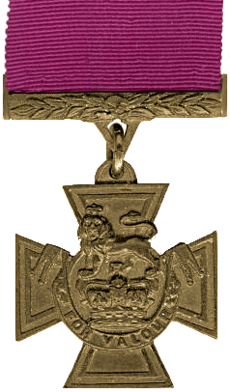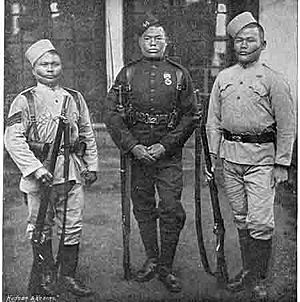List of Brigade of Gurkhas recipients of the Victoria Cross facts for kids

The Victoria Cross (VC) is a very special military decoration given to members of the British or Commonwealth armed forces. It's awarded for amazing acts of bravery or gallantry when facing the enemy. In the British honours system and many Commonwealth countries, it's the highest award a soldier can get for actions in battle. It was created in 1856. Since then, it has been awarded 1,356 times, with three people even receiving it twice!
The British Army has a group of soldiers called the Brigade of Gurkhas. These units are made up of brave soldiers from Nepal. They have been part of the British Army since 1815. Originally, British officers led them. The Gurkhas first focused on conflicts in the Far East. Later, when Hong Kong was transferred from British to Chinese control, the brigade moved its main base to the UK. A battalion of Gurkhas still serves in Brunei, and as of 2016, units were also serving in Afghanistan.
History of Victoria Cross Awards to Gurkhas
Since the Victoria Cross was first introduced, it has been given to Gurkha soldiers or British officers serving with Gurkha regiments 26 times. The very first award was in 1858. It went to a British officer of the Gurkhas named John Tytler. This happened during the campaigns that followed the Indian Rebellion of 1857.
At first, Gurkhas and other local troops from the British East India Company Army or the British Indian Army could not receive the Victoria Cross. Because of this, until 1911, all Gurkha recipients of the award were British officers. These officers were attached to Gurkha regiments. Before 1911, the highest award Gurkhas could get was the Indian Order of Merit.
The first time a native Gurkha soldier received the Victoria Cross was in 1915. This was Kulbir Thapa, during the First World War. Since 1911, 16 VCs have been awarded to men serving with Gurkha regiments. Out of these, 13 have been given to native Gurkhas. The most recent award was in 1965 to Rambahadur Limbu. This happened during the Indonesia–Malaysia confrontation. The Gurkha regiments are among the most highly decorated units in the Commonwealth, similar to the Royal Green Jackets.
Bravery Awards for Gurkhas
In 1950, India became a republic. After this, Gurkhas serving in the Gurkha regiments of the Indian Army could no longer receive the Victoria Cross. They are now covered by the Indian honours system. Under this system, the Param Vir Chakra (PVC) is India's highest military award for bravery. It is considered to be like the Victoria Cross. So, only Gurkhas serving in the British Army can still receive the Victoria Cross.
Gurkha soldiers have also received two George Cross (GC) medals. The George Cross is given for acts of bravery that are not in combat. It is for gallantry shown when not facing an enemy. In the UK honours system, the George Cross is just as important as the Victoria Cross. This has been the case since the George Cross was created in 1940.
Victoria Cross Recipients from the Gurkha Brigade
This along with the *, indicates that the Victoria Cross was awarded posthumously (after the person died).
| Name | Unit | Date of action | Conflict | Place of action |
|---|---|---|---|---|
| John Tytler | 66th Bengal Native Infantry later 1st King George V's Own Gurkha Rifles | 1858 | Indian Rebellion of 1857 | Choorpoorah, India |
| Donald Macintyre | Bengal Staff Corps attached to 2nd King Edward VII's Own Gurkha Rifles | 1872 | Looshai Expedition | Lalgnoora, India |
| George Channer | Bengal Staff Corps attached to 1st King George V's Own Gurkha Rifles | 1875 | Perak War | Perak, Malaya |
| John Cook | Bengal Staff Corps attached to 5th Royal Gurkha Rifles | 1878 | Second Anglo-Afghan War | Peiwar Kotal, Afghanistan |
| Richard Ridgeway | Bengal Staff Corps attached to 8th Gurkha Rifles | 1879 | Naga Hills expeditions | Konoma, India |
| Charles Grant | Indian Staff Corps attached to 8th Gurkha Rifles | 1891 | Manipur Expedition | Thobal, Burma |
| Guy Boisragon | Indian Staff Corps attached to 5th Royal Gurkha Rifles | 1891 | Hunza–Naga campaign | Nilt Fort, India |
| John Manners Smith | Indian Staff Corps attached to 5th Royal Gurkha Rifles | 1891 | Hunza–Naga campaign | Nilt Fort, India |
| William Walker | 4th Prince of Wales' Own Gurkha Rifles | 1903 | Third Somaliland Expedition | Daratoleh, Somaliland |
| John Grant | 8th Gurkha Rifles | 1904 | British expedition to Tibet | Gyantse Jong, Tibet |
| Kulbir Thapa | 3rd Queen Alexandra's Own Gurkha Rifles | 1915 | First World War | Fauquissart, France |
| George Wheeler | 9th Gurkha Rifles | 1917 | First World War | Shumran, Mesopotamia |
| Karanbahadur Rana | 3rd Queen Alexandra's Own Gurkha Rifles | 1918 | First World War | El Kefr, Egypt |
| Lalbahadur Thapa | 2nd King Edward VII's Own Gurkha Rifles | 1943 | Second World War | Rass-es-Zouai, Tunisia |
| Gaje Ghale | 5th Royal Gurkha Rifles | 1943 | Second World War | Chin Hills, Burma |
| Michael Allmand | Indian Armoured Corps attached to 6th Gurkha Rifles | 1944* | Second World War | Pin Hmi Road Bridge, Burma |
| Tulbahadur Pun | 6th Gurkha Rifles | 1944 | Second World War | Mogaung, Burma |
| Netrabahadur Thapa | 5th Royal Gurkha Rifles | 1944* | Second World War | Bishenpur, Burma |
| Sher Bahadur Thapa | 9th Gurkha Rifles | 1944* | Second World War | San Marino, Italy |
| Agansing Rai | 5th Royal Gurkha Rifles | 1944 | Second World War | Bishenpur, Burma |
| Thaman Gurung | 5th Royal Gurkha Rifles | 1944* | Second World War | Monte San Bartolo, Italy |
| Frank Blaker | Highland Light Infantry attached to 9th Gurkha Rifles | 1944* | Second World War | Taunggyi, Burma |
| Ganju Lama/Gyamtso Shangderpa | 7th Gurkha Rifles | 1944 | Second World War | Ningthoukhong, Burma |
| Lachhiman Gurung | 8th Gurkha Rifles | 1945 | Second World War | Taungdaw, Burma |
| Bhanbhagta Gurung | 2nd King Edward VII's Own Gurkha Rifles | 1945 | Second World War | Snowdon East, Tamandu, Burma |
| Rambahadur Limbu | 10th Princess Mary's Own Gurkha Rifles | 1965 | Indonesia–Malaysia confrontation | Sarawak, Borneo |


